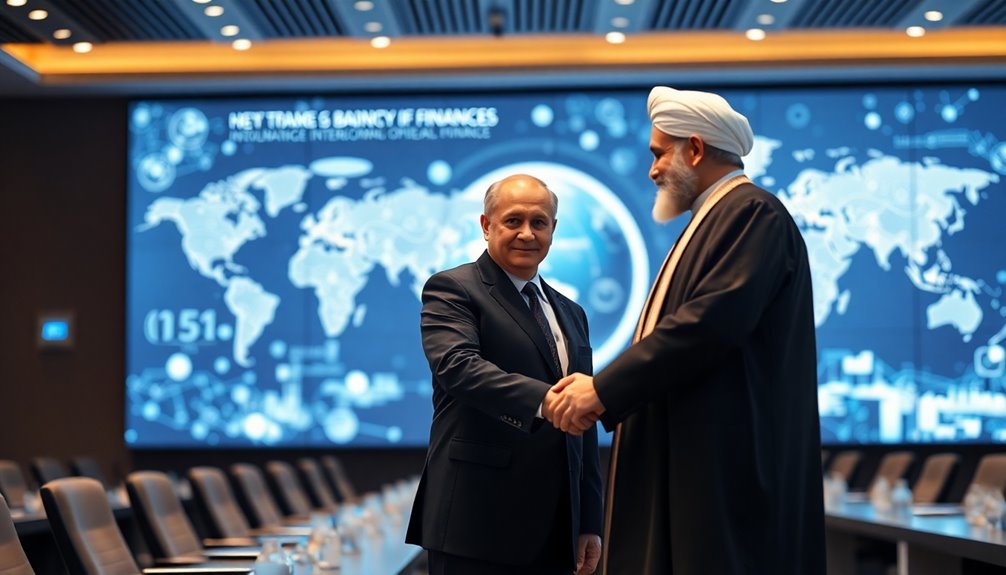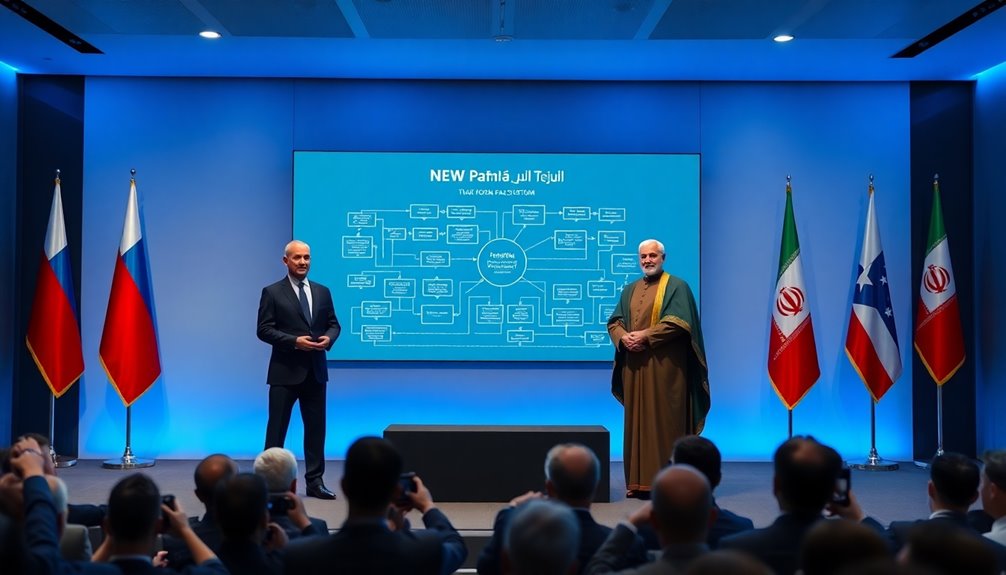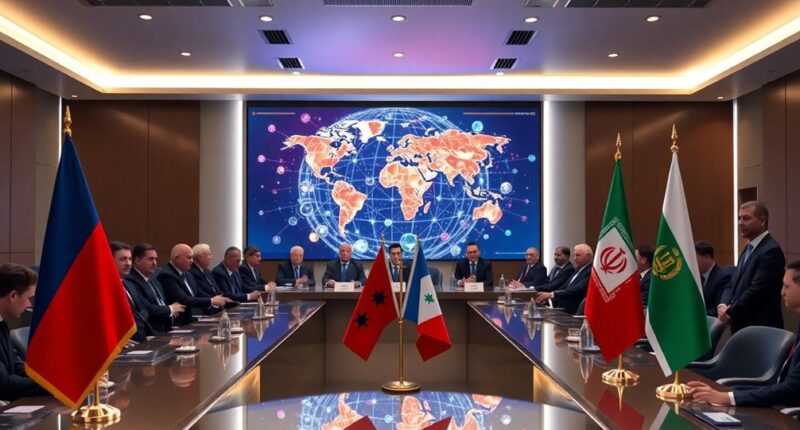Russia and Iran have recently unveiled a new payment system aimed at reshaping global finance by circumventing SWIFT. This innovative platform connects hundreds of banks from both countries, focusing on transactions in national currencies like the rouble and rial. It enhances trade efficiency and mutual acceptance of bank cards, making cross-border transactions seamless. With increased bilateral trade and strategic economic partnerships, this system serves as a vital response to Western sanctions. As this initiative unfolds, you'll uncover the implications for international finance and how it might impact future economic relations.
Key Takeaways
- Russia and Iran launched a new payment system connecting interbank networks to facilitate cross-border transactions and reduce reliance on SWIFT.
- The system integrates Russia's SPFS with Iran's SEPAM, allowing transactions in national currencies, rouble and rial, promoting economic independence.
- Approximately 700 Russian banks and 106 non-Russian banks from 13 countries are now linked to this alternative payment network.
- The initiative aims to counter Western sanctions and enhance bilateral trade, which rose by 31% in 2022.
- Geopolitical tensions have driven the shift towards alternative payment systems, reducing Western influence in global finance.
New Payment System Launch

Iran and Russia have officially launched a new payment system that connects their interbank communication networks, allowing for seamless cross-border transactions. This innovative system aims to bypass the US-based SWIFT financial messaging system, a move both countries see as crucial for their economic independence. With around 700 Russian banks and 106 non-Russian banks from 13 countries linked, the system integrates Russia's SPFS with Iran's SEPAM, enhancing financial collaboration. Additionally, Iranian banks will connect to Russia's Mir payment system, facilitating smoother transactions. This development not only strengthens bilateral trade, which surged by 31% in 2022, but also paves the way for future economic partnerships amid ongoing Western sanctions. The establishment of this new system aligns with both nations' strategies to mitigate the impact of US financial sanctions.
SWIFT Alternative Announced Today

Today marks a significant step forward as Iran and Russia unveil their long-anticipated alternative to the SWIFT financial messaging system.
This new platform connects Iran's Shetab and Russia's SPFS, facilitating cross-border transactions for around 700 Russian banks and 106 banks from 13 countries. By promoting the use of national currencies like the rouble and rial, the system aims to reduce reliance on the US dollar. Additionally, this development aligns with the ongoing efforts to create a joint financial messaging system between China and Russia.
You can expect enhanced trade capabilities, including Letters of Credit between banks. Moreover, Iranian bank cards will soon work in Russia, while Russian cards will be accepted in Iran.
This initiative not only counters Western sanctions but also seeks to strengthen economic ties and regional influence.
Global Payment System Shifts

As the landscape of global finance continues to evolve, shifts in the payment system are becoming increasingly apparent. Real-time payments (RTPs) are leading the charge, enabling instant, low-cost transactions that cut out intermediaries like SWIFT.
Initiatives such as FedNow and UPI are expanding, paving the way for seamless cross-border RTPs. Global standardization will further streamline transactions and boost efficiency. Additionally, the interoperable systems being developed across various regions aim to bridge diverse payment networks for improved connectivity.
Meanwhile, digital currencies, especially central bank digital currencies (CBDCs), will reshape how you conduct transactions, making cross-border payments faster and more secure.
As decentralized finance (DeFi) gains traction, it offers an alternative to traditional networks, enhancing financial inclusion and connecting the global economy.
These shifts are transforming how you interact with money on a global scale.
Adoption by Major Banks

Major banks are increasingly recognizing the potential of alternative payment systems, particularly the SPFS, as a viable substitute for SWIFT.
With over 700 Russian banks and 106 non-Russian banks from 13 countries now connected, the SPFS is gaining traction.
Iranian banks, no longer reliant on SWIFT, can efficiently transact with their Russian counterparts, enhancing interbank communication.
By the end of 2021, around 40 foreign entities, including banks from Germany and Japan, had joined the SPFS network.
This system aims for global reach, enabling cross-border transactions without dependence on Western payment systems. The limitations of SWIFT have fueled the demand for such alternatives in the global payment landscape.
As financial cooperation deepens, the SPFS stands to reshape economic interactions, providing a robust alternative in a shifting landscape.
Geopolitical Tensions Impacting Adoption

The growing adoption of alternative payment systems like SPFS highlights the urgent need for countries like Russia and Iran to navigate the complex landscape shaped by geopolitical tensions.
As both nations face harsh sanctions, their disconnection from SWIFT significantly hampers international trade and economic stability. You can see how Iran's foreign trade plummeted by 30% after being excluded from SWIFT, while Russia anticipates a 5% GDP drop due to similar isolation. In response, they're shifting towards using national currencies and developing systems like SEPAM. This strategic pivot aims not only to circumvent US dollar dominance but also to strengthen ties through partnerships and alliances, reflecting a broader geopolitical strategy to mitigate Western influence in global finance. The implications of these sanctions extend to geopolitical tensions, as nations with strained relations with the U.S. may seek alternatives for payment processing.
Long-term Economic Implications

While navigating the shifting landscape of global finance, Russia and Iran's efforts to establish alternative payment systems could reshape long-term economic dynamics. By promoting de-dollarization and using their national currencies, you'll notice increased trade volumes, especially between these two nations. Their initiatives, like the Mir payment network, are gaining traction, accounting for over 25% of card transactions in Russia. Moreover, as Western sanctions continue to isolate both nations economically, they will likely accelerate their collaboration in developing these systems. However, challenges remain, such as the limited acceptance of the digital ruble outside Russia. As both countries deepen economic cooperation, they'll face increased isolation from Western markets. Ultimately, their push for new financial systems could lead to a redefined global trade landscape, with potential new markets opening up, but economic vulnerabilities will continue to pose risks.
Frequently Asked Questions
How Does the New Payment System Ensure Transaction Security?
The new payment system ensures transaction security through advanced encryption technologies, which protect your sensitive data from unauthorized access.
It verifies the legitimacy of all parties involved and continuously monitors for unusual activities.
You'll benefit from robust authentication measures and secure messaging protocols to keep your transactions safe.
Plus, compliance with regulatory standards builds trust and confidence, while enhanced cybersecurity measures, like employee training and fraud prevention tactics, further safeguard your transactions.
What Countries Are Likely to Adopt This Payment System?
You'll likely see countries like Iran, Iraq, and Afghanistan adopting this new payment system.
Iran's already connected its banking with Russia's, while Iraq could benefit from stronger ties with both nations.
Afghanistan, facing economic challenges, might find this system essential for trade.
Each of these countries aims to enhance regional cooperation and reduce reliance on Western financial systems, making this alternative a crucial tool for their economic interactions.
Will This Alternative Affect Existing Currency Exchange Rates?
You might see that the introduction of alternative payment systems could impact existing currency exchange rates.
As countries shift away from using dominant currencies like the US dollar, you could notice fluctuations in their values. This shift may lead to a rise in competition among currencies, affecting trade dynamics and pricing.
If more nations adopt these alternatives, the dollar and euro's influence could diminish, resulting in a more complex global financial landscape.
Can Smaller Businesses Utilize This Payment System?
Imagine navigating a bustling marketplace, but instead of familiar paths, you're faced with a maze of new routes.
Smaller businesses can struggle to utilize this payment system due to compatibility issues and higher transaction fees. You might find the security measures daunting, while slower transaction speeds could leave you frustrated.
With limited networks and complex regulations, adapting might feel like trying to catch smoke with your bare hands—challenging and uncertain.
How Will This Impact Global Trade Agreements?
You'll notice that the emergence of an alternative payment system can significantly impact global trade agreements.
It reduces reliance on the US dollar, promoting national currencies instead. This shift could lead to new trade blocs and enhance economic ties among participating countries.
Additionally, as transaction processes become more efficient and secure, you may see increased international collaboration, which could reshape financial dynamics and create opportunities for those looking to engage in global trade.
Conclusion
As Russia and Iran unveil their new payment system, the world watches closely. Will this alternative to SWIFT gain traction among major banks, or will geopolitical tensions stifle its growth? The implications are vast, potentially reshaping global finance as we know it. As more countries weigh their options, the stakes are higher than ever. You can't help but wonder: is this the dawn of a new economic order, or just another fleeting moment in history?









